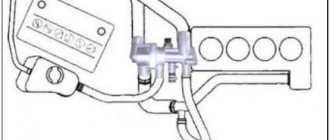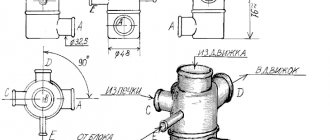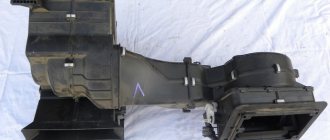Any car has an engine cooling system, which must maintain the operating temperature of the engine. The main element responsible for the stable temperature of the coolant is the thermostat; it regulates when to pass coolant through the cooling radiator and when to bypass it.
When this element fails, the car engine begins to operate in incorrect temperature conditions, which can lead to its breakdown.
In this article we will talk about the thermostat on a Lada Granta car, signs of its malfunction, methods of checking and replacing it yourself.
What is a thermostat and what is it for?
The thermostat (TC) is an automatic device that regulates the temperature of the coolant. The main purpose of the device is to promote rapid heating of the engine and at the same time prevent it from overheating. The coolant (coolant) first circulates through a small ring (ICE jacket - pump) until its temperature reaches 89–92 °C. Then the vehicle opens the valve, directing the coolant flow into the large ring of the cooling system (radiator - heat exchanger - expansion tank).
While the engine is running, the thermostat valve is in constant motion, reducing or increasing the flow of coolant into the second large circuit, depending on the intensity of engine operation and the air temperature outside the car.
Features of the LADA Granta cooling system
As in previous LADA models, upon reaching a certain temperature, the thermostat switches the coolant flow from a small to a large circuit. The small circuit includes:
- cylinder water jacket;
- water pump;
- interior heater.
The difference is that the heater radiator is connected to a small circuit in series and not in parallel. This forces all the coolant to pass through it, improving the heating of the cabin. The thermostat opening temperature is 85 degrees. Upon reaching this mark, the valve opens and the liquid begins to circulate through a large circuit into which. In addition to the small circuit elements, a cooling radiator is included. The advantage of the modernized cooling system is that antifreeze from the engine jacket falls directly onto the thermostat thermocouple without mixing in its housing. This allows the element to respond to the actual engine temperature, opening on time and preventing overheating. The manufacturer has set the permissible thermostat opening range to 85–7 degrees. That is, it can open at both 78 and 93 degrees. According to the official letter from the manufacturer, sent to dealers, the operating temperature of the Grant engine may be 10 degrees lower than that of previous VAZ models. This does not mean that the engine is “underheated” and does not lead to an increase in fuel consumption, deterioration of lubrication and a decrease in engine life. However, owners of the LADA Grant often change the thermostat to a new one, with an opening temperature closer to 90 degrees, or modify the standard thermostat by changing the thermal element.
How to check Grant's thermostat
There may come a time when the vehicle stops functioning normally and phenomena such as:
- a significant increase in the warm-up time of the internal combustion engine;
- rapid boiling of the coolant after reaching a temperature of 92 °C;
- excessive fuel consumption;
- The engine does not warm up to the required temperature in winter.
In this situation, you need to know how to check the thermostat. This can be done in three ways.
- Tactile method
- Visual control
- Laboratory test
Tactile method
The engine is warmed up until the sensor readings on the instrument panel reach the desired value. Raise the hood and feel the lower radiator outlet pipe with your hand. If the device is working properly, the hose will be hot. However, the method does not provide a complete picture of the performance of the vehicle.
Visual control
The device is removed from the car and placed in a container, suspended in water. The movement of the valve will be visually visible. When the water boils, the seat will lower, revealing the hole. During cooling, the valve will, on the contrary, rise and close the passage.
Laboratory test
The thermostat is also placed in an aqueous environment, but rested on a solid base. A tripod with a dial indicator is connected to the vessel with water, the rod of which will rest rigidly on the upper valve of the vehicle. When the water is heated, the indicator readings are recorded. But this method is quite difficult to implement in a garage, so Lada Granta drivers rarely use it.
Tips for repairing a temperature control device are often published on the Internet. But this should not be done due to the fact that the device cannot be fully restored. It is best to buy and install a new thermostat on Grant.
No. 3 Modification of the thermostat on the Lada Grant - heating the throttle valve
The throttle valve on the Lada Granta is not heated. In winter, in severe frosts, metal structures slightly grab, which is noticeable while driving a car.
There is only one way to protect the unit from freezing - to run the circuit from the cooling system.
Sequencing
- We place the car on the inspection hole and remove the metal protection of the oil pan.
- Drain the antifreeze.
- We release the clamps - ties, remove the rubber supply and return pipes.
- We dismantle the flow regulator, fix it in a vice, and disassemble it into its component elements.
- In the back of the case we drill an additional hole at “10”.
- Using argon welding, we weld the fitting to the hole for partial intake of antifreeze from the thermostat (Luzar).
- We assemble the structure.
- We put the rubber pipe on the fitting.
- We fill the system with antifreeze.
- We start the engine and test the proper operation of the stove heater.
Note to the driver! In this method of modification, the standard studs must be replaced; the body of the fitting rests against the wall of the block. Replace the studs with new ones, 8 mm in diameter, 10 cm long.
Signs of breakdown
The thermostat is a fairly simple element, however, and it is not immune to breakdowns. Normally, after starting a cold engine, the lower hose extending from the radiator does not heat up for some time, but after the coolant temperature exceeds 85C (±2C), it begins to quickly heat up (provided the thermostat is in full working order). It is this aspect that will accurately indicate to the car owner the moment the coolant begins to circulate.
In cases where the valve cannot open, the coolant stops circulating and the engine begins to overheat. Overheating also causes incomplete opening of the valve. A delay in closing the valve, on the contrary, creates conditions for a longer warm-up of the engine, especially in the cold season.
As a rule, thermostat failure is caused by the following reasons:
- an unstable engine (triplication often leads to valve damage);
- wear of the rubber gasket;
- corrosion (it is the most common cause of breakdowns);
- antifreeze gets inside the thermostat;
- there is a leakage of wax from the device;
- there is mechanical damage on the valve.
Most often, a malfunction of the thermostat leads to the impossibility of further movement in the car, and therefore the faulty part must be replaced immediately.
Carrying out an inspection
The process of checking the thermostat is a relatively simple procedure. To begin, the removed thermostat bottle is lowered into a transparent container into which coolant has previously been poured. Next, this container is heated, periodically stirring the coolant and monitoring with a thermometer the moment when the cylinder rod begins to move. When the coolant reaches a temperature of 85C (±2C), the rod of a fully working device will begin to extend. When the liquid in the container is heated to 100C (±2C), it will extend completely.
Thermostat opening and closing temperatures on Grant
The thermostat has two valves: main and additional. At a fluid temperature of up to 85 °C , the thermostat is tightly closed, and it circulates in a small circle, bypassing the radiator, which helps to warm up the engine as quickly as possible. As soon as the temperature rises from 86° C , the thermostat begins to gradually open and at a coolant temperature of 102° C , it opens completely, ensuring its passage in a full circle through the radiator.
Thus, it becomes clear that the thermostat starts working already from 86 °C.
Video review of the factory thermostat
| Name / article / OEM | Price, rub.) |
| Thermostat Lada Granta Behr-Hella | From 1200 |
| Lada Granta (winter 92C) luzar 92LT 0192 OEM: 2190-1306010-92 | From 1150 |
| Thermostat Luzar (LUZAR)LT 0190 OEM 21900-1306010-00 | From 1150 |
| Wahler thermostat WL54546435 | From 1300 |
| Behr Thermot-Tronik2190-1306010 | From 1250 |
| Thermostat Lada Granta Luzar 92LT01082 21082-1306010 | From 1100 |
How to change the thermostat of LADA “Granta”
The LADA Granta is equipped with power units with 6 and 8 timing valves. The location of the thermostat in these models is different, and accordingly, the replacement procedure is also different.
To replace the thermostat on the eight-valve Granta version you need:
- Phillips screwdriver;
- socket wrenches for 10 and 13;
- crosshead screwdriver;
- key T30;
- container for coolant.
Replacing the LADA Granta thermostat (8 valve) is performed as follows:
- install the LADA Granta on a site that has a slope so that the front part is higher than the rear;
- unscrew the bolts securing the engine protection and remove it;
- place a container for coolant under the radiator;
- remove the cap covering the expansion tank;
- Unscrew the drain plug on the radiator;
- drain the coolant into a container;
- tighten the drain plug on the radiator;
- press the latch and disconnect the wiring block from the coolant temperature sensor;
- loosen the clamp securing the rear hose to the thermostat cover pipe;
- remove the hose from the pipe;
- loosen the clamp securing the front hose to the thermostat cover pipe;
- remove the front hose from the pipe;
- unscrew the nut holding the ground wire to the thermostat mounting stud;
- remove the washer and the ground wire tip from the stud;
- unscrew the two nuts securing the thermostat to the engine, remove and set aside the washers;
- pull the thermostat housing off the studs;
- remove the thermostat gasket;
Important: when removing or replacing the thermostat, the sealing gasket must be replaced with a new one!
- unscrew the three bolts holding the thermostat cover;
- remove the cover;
- press out the thermostat fixing plate, overcoming the resistance of the spring;
- turn the plate, remove it from the grooves and pull it out;
- remove the spring;
- pull the thermostat out of the housing.
general information
There are single-valve, two-stage and two-valve thermostats, as well as electronically controlled devices. Grants are equipped with thermostats Luzar LT0191 and Luzar LT0190 (costing from 450 rubles for the first, and from 800 rubles for the second), FENOX TS034E7 (costing from 800 rubles), VAZ-2123 (article 2123-1306010, cost from 650 rub.). It is worth mentioning such devices as VAZ-2101 GATES (article TH14580, cost - from 350 rubles), VAZ-2121 GATES (article TH15380, approximate cost - from 500 rubles), VAZ-2110 (article 21082-1306010, cost - from 600 rub.) and other devices. They are located between the engine and the radiator, but it should be noted that there are differences in the location of the thermostats on Grants with eight-valve and sixteen-valve engines.
Their main task is to prevent the movement of antifreeze through the radiator until the car engine warms up to the required temperatures. Accordingly, if the car engine does not warm up, then the coolant does not move in a large circle. Usually the thermostat is activated when the engine reaches a temperature of 80-95C. Among other things, the thermostat helps reduce the amount of harmful emissions released into the atmosphere and minimize engine wear.
The thermoelement located inside the device is made of brass, has a cylindrical shape and is filled with artificial wax. When the engine reaches a temperature of approximately 82C, this substance begins to melt, which causes it to expand. This sets the valve in motion, it opens, after which the antifreeze begins to circulate through the car’s radiator. Turning off the motor causes the wax to solidify inside the thermostat and close the damper.
Below we will talk in more detail about possible malfunctions of thermostats, provide instructions for replacing and checking them, and also share a technique for reworking and upgrading this part, allowing you to increase its response threshold to 92C.
Replacing the thermostat from 77C to 92C
Many Grant owners complain about rather problematic and weak thermostats in their cars. Most of the complaints are related to the fact that the device allows access to antifreeze after the engine has warmed up to 80C. In fact, there is no malfunction in this, it’s just a feature of the operation of specific engines - they are initially configured to operate at this temperature.
Most often, such features are not taken seriously by car owners, and do not interfere with the functioning of the engine. Perhaps the only noticeable difference will be cooler air inside the car at sub-zero temperatures outside. However, converting the car to gas fuel will significantly complicate this situation.
ATTENTION. For some AVTOVAZ engines, a temperature of 77-80 degrees Celsius is the operating temperature. There is no need to change the thermostat as it is working properly.
In such circumstances, the element can be modified, although not recommended by the manufacturer, after which it will open at 92C. The modification will require the purchase of a new thermostat, however, replacing the entire part will not be necessary; all you need from the new thermostat is a sensor.
When is it necessary to replace the LADA Granta thermostat?
The thermostat should be changed if it does not close a large circuit even when the engine is hot or opens at temperatures above 92 degrees. In the first case, the engine does not warm up enough, which impairs the combustion of the air-fuel mixture and the circulation of oil through the oil channels. When opening late, at best, the cooling fan often turns on; at worst, the crankshaft bearings fail or the engine head becomes deformed, which requires complex, expensive repairs. The design of the LADA Granta thermostat does not provide for its repair, so the failed part must be replaced with a new one. You can verify that the thermostat is working without removing it from the car by feeling the temperature of the pipes of the large cooling circuit or the bottom of the radiator. They should be cold until the engine reaches operating temperature. After the engine warms up, the thermostat opens and the elements of the large circuit should heat up.
Owner reviews
| № | Positive |
| 1. | Gennady: 65,000 km, no comments on the cooling system elements. For my part, I try to systematically carry out technical inspections and fill in high-quality antifreeze. |
| 2. | Vladimir: at 75,000 km I replaced the “regulator” for the first time, I think that for a domestic car the service life is more than good. |
| 3. | Alexander: During the two years of operation of the machine, breakdowns occurred, but there were no large-scale ones. I eliminated the unimportant ones on my own. Of course, “our” manufacturer is far from perfect, but the quality is an order of magnitude higher than previous modifications. |
| 4. | Sergey: The stove heater in Grant heats very well, it’s hot, I often open the windows for ventilation. I don't remember early models having this quality. |
| 5. | Vasily: I’m pleased with the build quality of the domestic car; there are some faults, but they can be easily fixed on your own. |
| 6. | Gennady: after buying the car, I immediately drained the “native” antifreeze and filled it with high-quality imported one. The cooling system works like a clock. |
| 7. | Dmitry: I’m happy with the car, the units are working as normal. I follow the maintenance schedule and buy original parts. |
| Negative | |
| 1. | Kirill: I drove 35,000 km without any breakdowns, and then the car started to fall apart. In a year and a half, I have already visited a service station twice unscheduled for diagnostics. |
| 2. | Stepan: I regretted that I bought Grant, the model is crude, there are many flaws and defects. The manufacturer is in no hurry to fix it. |
| 3. | Victor: don’t rush to buy Grant; Renault Logan can be used as a good alternative. |
Properly assembled thermocouple
No. 2 Modification of the thermostat on the Lada Grant - replacement of the thermal insert
This method involves completely dismantling the flow regulator and disassembling it into its component elements. The detailed process is described above.
We troubleshoot the thermostat cavity, wipe it with a rag, and inspect it for cracks and other defects.
Removed spring from thermocouple
We replace the entire “core”. The following cores are suitable for the standard thermostat:
- Wahler: 3017.87 D (at 87°C);
- Behr (Behr) 3091.92V (at 90°C).
We replace the complete set, including the spring, and the modification of the Luzar thermostat on the Lada Grant is completed.
Note to the driver! Such modernization is possible only with thermostats manufactured by BEHR. Products from other companies are incompatible in terms of parameters. Many car owners do not know about these subtleties and end up in ridiculous situations.
Thermostat under the cover in disassembled form.
As an alternative, use the core from Daewoo or Renault, catalog part number - Vernet 4898.92. The design of the part is somewhat different and requires adjustment. For standard thermostats from Luzar, such an upgrade is not possible.
Subject to the recommendations, fuel consumption will decrease by 1.0 - 1.5% minimum.











